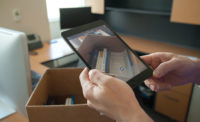Room measurements, and the digital floor plans created using them, are the critical basis for most well-crafted estimates. They are essential for determining the quantities of material and labor needed to repair a structure and the overall cost of the repair.
Measurements are also a common source of redundant work when estimators write or record dimensions for later entry into an estimating system. Estimators often juggle tape measures, pens, pencils, note pads, laptops, tablets, laser distance measurers, and so on as they constantly switch from one device to the other when taking and recording measurements.
Advanced apps on smart devices equipped with cameras and gyroscopes present a welcome opportunity for estimators to quickly capture room dimensions and draw floor plans from a single device. With this technology, iPhones, iPads, and many Android devices can be effectively substituted for a tape measure and, more importantly, eliminate double entry.
Here are a few points to consider for the best results when using measuring apps on smart devices.
First, look for dimensioning technology that was designed to meet the needs of restoration estimators. Some apps are built for real estate agents and “do-it-yourself” homeowners who are just looking for quick structural renderings. These apps help users plan furniture layouts or get ballpark approximations for carpet or paint. Using dimensioning technology that was developed specifically for estimating restoration work is the first step toward achieving optimal results.
Next, make sure the app can be fine-tuned using built-in calibration and then take time to carefully calibrate the app prior to dimensioning. This is a crucial step that usually only takes seconds. Smart-device dimensioning technology relies on the device’s built-in viewfinder and gyroscope to track and measure movement. The app then uses advanced mathematical algorithms to calculate dimensions. Properly calibrating the application is a key step toward getting the needed results.
A few other strategies can help to improve the quality of the dimensions, including learning and using the proper techniques. Generally, this means holding the device at a consistent height when dimensioning. Too much variation in position can impact results just as too many bends in a tape measure that crosses a couch, chair, and a hutch can throw off a measurement. It is also helpful to understand the limitations of dimensioning technology. Just as the quality of photos taken on a device are affected by low light and too much movement, the quality of dimensions can be affected by dark rooms, obscured corners, debris, and room complexity. All these factors should be considered when using the technology.
Another key to effective dimensioning is to use an app with technology that allows estimators to move around the room to get the best view of each individual wall. Some approaches require the user to remain in the middle of the room and rotate with minimal movement until the entire room is measured. This often works when dimensioning basic rooms, but doesn’t work at all, or the level of detail drops precipitously, when measuring complex rooms. The best approach is to measure each wall just as you normally would—with complete freedom to move from wall to wall.
The last and most important key for selecting mobile dimensioning technology is to make sure the measurements build a floor plan that flows directly into an estimating system. Diagrams in some apps can only be exported as JPEGs, PNGs, or PDFs, and this often does little to streamline the workflow because estimators still need to reenter the data into their estimating system.
With the right estimating system, users can measure the structure with a mobile device and instantly create a digital floor plan. It’s very important that the floor plan is editable. An estimator who makes one bad measurement on a static floor plan will usually have to recreate the entire diagram. Integrated technology that creates an editable floor plan allows estimators to easily modify the floor plan.
Mobile dimensioning technology holds great promise for reducing the hassle of dimensioning a structure. With just a little practice and experience, estimators can save significant time getting the dimensions and floor plans they need to compile a restoration estimate.






Report Abusive Comment